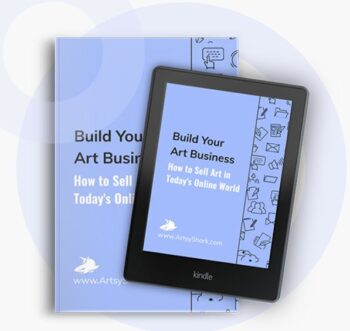by Carolyn Edlund
Writing about yourself can seem like a difficult task, but it doesn’t have to be overly complicated. Here’s how to create an authentic bio that speaks to your audience.

Your portfolio is the center of your work as an artist. But there are important supporting documents that function alongside your portfolio, and your artist bio is one of them. Write a strong artist biography to inform and engage collectors, curators, gallerists and others in the art world who may be considering your art. Keep your intended audience in mind when writing that all-important bio. Below are lists of what to include and avoid.
You might be applying for an exhibition or grant, or perhaps you’re working on content for the About page on your website. Regardless of the purpose, your artist bio should act as a distinct introduction to who you are, what you create, and why it matters.
What Exactly is an Artist Biography?
An artist biography is a short summary of your background, body of work, technique and achievements. It’s not the same as your artist statement, which focuses more on your ideas and artistic process. The artist bio is also distinct from a personal bio, being highly focused on your life, work and goals as an artist specifically. And it has certain purposes, such as applying to a gallery, residency or exhibition, or sharing information with potential collectors. You might want to keep several versions to use for different reasons.
What to include:
A great artist bio usually contains a few key essentials that stand out and bring you as the artist to life for the reader.
Who you are. Start with your name and a bit about where you’re from or currently based.
What you create. Describe your medium, style, or subject matter in clear terms. What kind of work do you make? Are you a painter, sculptor, digital artist, mixed-media creator? Share the mediums you work in and describe your style in broad terms: abstract, figurative, conceptual, minimalist, etc.
Why you create it. Share the themes or ideas that drive your work. Who or what inspires you—other artists, personal experiences, nature, culture, philosophy? This helps your audience connect with the “why” behind your work.
Your background. This might include education, training, or how you got started, especially if you’re self-taught. In that event, share how you’ve built your knowledge. This might include workshops, mentorship, independent study, or personal practice.
Your career highlights. Mention exhibitions, awards, collections, residencies, press mentions, or other achievements. Select the milestones that carry the most weight for your biography.
Current direction. End with what you’re working on now or what’s coming next.
Not every artist bio needs all of these elements; sometimes they are not relevant. It’s up to you to decide what gives the clearest picture of your life as an artist. Your bio should be constructed to be meaningful to your audience, or to serve the purpose behind a submission.
What to avoid:
A well-written bio is streamlined and succinct, yet filled with information. Stay away from the following mistakes that can ruin your efforts.
Going off-topic. Keep the subject on you as the artist, without veering off into irrelevant personal details. Omit any mention of your marital status, outside interests or political views, unless that information is directly tied to your artwork.
Overly technical jargon. This is a sure-fire way to confuse readers. Design your bio to be clear and accessible so it resonates with others easily. This respects the reader and communicates with everyone, regardless of their role.
Exaggeration. A boastful attitude is a turn off, and rarely impresses others. Your best presentation is grounded in being honest and straightforward.
Too much information. Don’t overwhelm your audience by listing every exhibition or event you have done. Instead, choose the most impactful or recent activities.
Throwaway phrases. Saying “I’ve been an artist my whole life” or something similar is a waste of valuable space in your bio. Make sure every word and sentence of your content is concise and filled with meaning, to give a genuine glimpse into your story.
Long, rambling verbiage. Run-on sentences and overlong paragraphs are confusing and frustrating to read. Keep your artist bio short and to the point.
Using abstract language. It’s unfortunately fairly common for artists to use Artspeak, language that sounds lofty or academic in their materials. Resist the urge to do so in your artist bio. Instead, write clearly and use plain English, even when describing complex ideas.
Length and tone.
Artist bios should generally fall into a word range of about 100–150 words. A shorter version of around 50–75 words in length is useful for social media profiles, catalogs, and submissions. A longer version of 200–300 words may be appropriate for grant applications, speaking engagements, or other uses you determine need a fuller description.
Traditionally, artist bios are written in third person (“Jane Smith is a painter based in Chicago”), and this works well for formal uses. But using first person tense (“I’m a painter based in Chicago”) feels more personal, and this can work exceptionally well where you are speaking directly to the reader, such as on your website or social media. Choose the tone that feels right for the particular audience you are targeting.
Keep your bio current.
Revisit your bio regularly to review and update it. As your career evolves, revise your bio to reflect new shows, awards and notable events, in addition to changes in style and technique. Keep a couple of versions on hand to adapt for different situations.
Your artist bio isn’t just about listing facts. It’s a chance to tell your story with clarity, warmth, and professionalism. Take the time to craft something that feels true to you, and don’t be afraid to let your personality shine through.
What if you are self-taught?
Are you an emerging or self-taught artist? You actually don’t need a degree or long list of exhibitions to write a strong bio. Instead, how you focus on what you do have in your experience is what matters to readers. Write about your personal story and the influences that inspire your work. Mention how you’ve built your skills and developed your voice. Authenticity is often more compelling than credentials.
Example of an artist bio.
The following example of an artist bio is about photographer Matthew Cortellesi, who is a self-taught artist in the process of growing his body of work and his fan base. This version of his artist bio resides on his website:
Matthew (Macky) Cortellesi was born in Greenwich Village and has lived most of his life in New York City. For years he has roamed the many streets of New York with camera in hand, searching for a unique way to capture the beauty and quirkiness of his beloved city. One day, he discovered that the city and its people were alive, well, and thriving in the thousands of pools (or droplets) of water that can be found throughout the city. In these reflections, it was nature dictating to Matthew where to aim his camera; the light, wind, sun, and clouds made the mundane majestic and majestic whimsical. Matthew understands that water is not stagnant. It does not sit still for a pose or wait patiently for the perfect shot. It is, in fact, the recording of these imperfect moments that Matthew celebrates and documents once-in-a-lifetime photographs.




Speak Your Mind